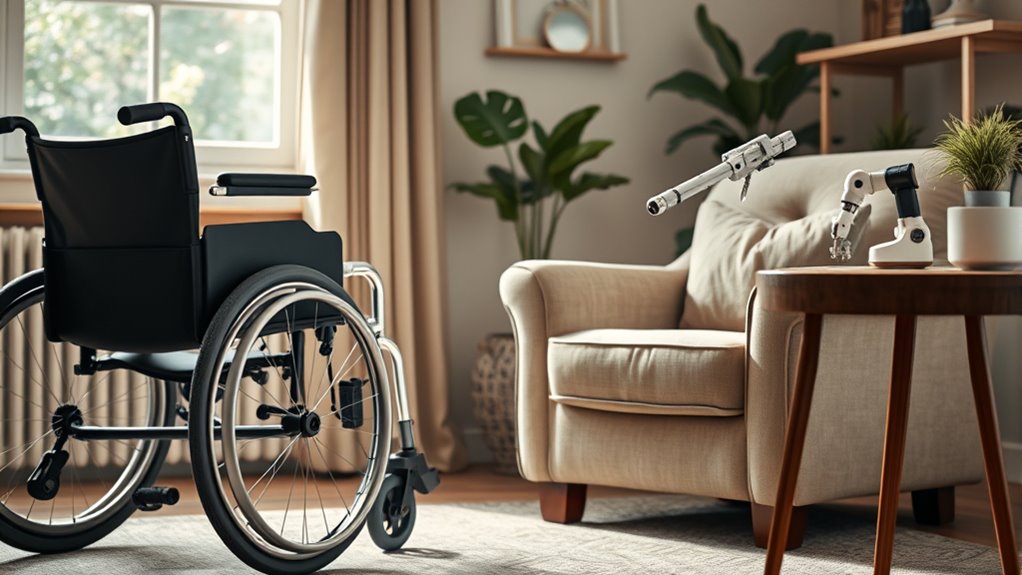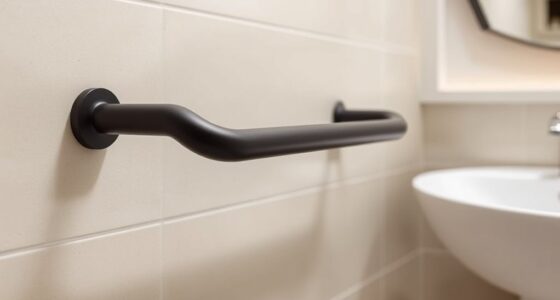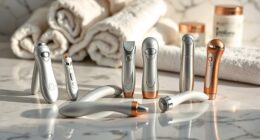Assistive devices for daily living are tools that help you stay independent and safe when performing everyday tasks like dressing, cooking, and moving around. These include mobility aids, personal hygiene tools, visual and hearing supports, and environmental safety equipment. Choosing the right devices involves evaluating your needs and consulting healthcare professionals. If you want to discover specific solutions tailored for your lifestyle, exploring further will provide helpful guidance.
Key Takeaways
- Assistive devices support independence and safety in daily activities like dressing, grooming, and mobility.
- Proper selection and regular review ensure devices meet individual needs and adapt to changing conditions.
- Devices include mobility aids, daily living tools, hygiene helpers, sensory aids, and environmental safety systems.
- Safety features such as non-slip surfaces, secure locks, and alarms prevent hazards and falls.
- Consulting healthcare professionals and testing devices in real-life settings optimize usability and effectiveness.
Understanding the Role of Assistive Devices in Daily Life
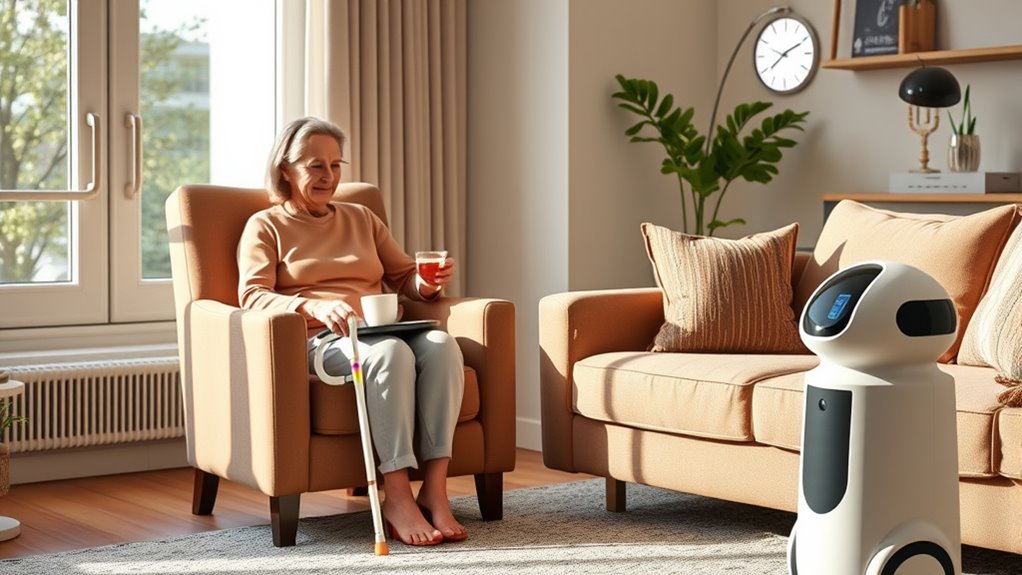
Assistive devices play a vital role in helping you perform daily activities safely and independently. These assistive tools support you in tasks like dressing, grooming, and moving around, reducing your reliance on others. Properly choosing the right assistive equipment and learning how to use it effectively are key to maximizing their benefits. When selecting devices, consider their compatibility with existing home systems to ensure seamless integration and ease of use. Additionally, understanding regional legal resources can help you access the appropriate support and guidance for obtaining and maintaining these devices. Staying informed about portable and lightweight options can further enhance your ability to maintain mobility and independence. By using assistive devices, you can maintain your independence longer and improve your overall quality of life. Properly choosing the right assistive equipment and learning how to use it effectively are key to maximizing their benefits. Whether it’s a mobility aid, a dressing stick, or environmental controls, each assistive device is designed to make everyday tasks easier. They empower you to stay active and engaged while promoting safety. Familiarity with assistive technology advancements can further enhance your ability to select the most effective tools for your needs.
Common Types of Adaptive Equipment for Home Use
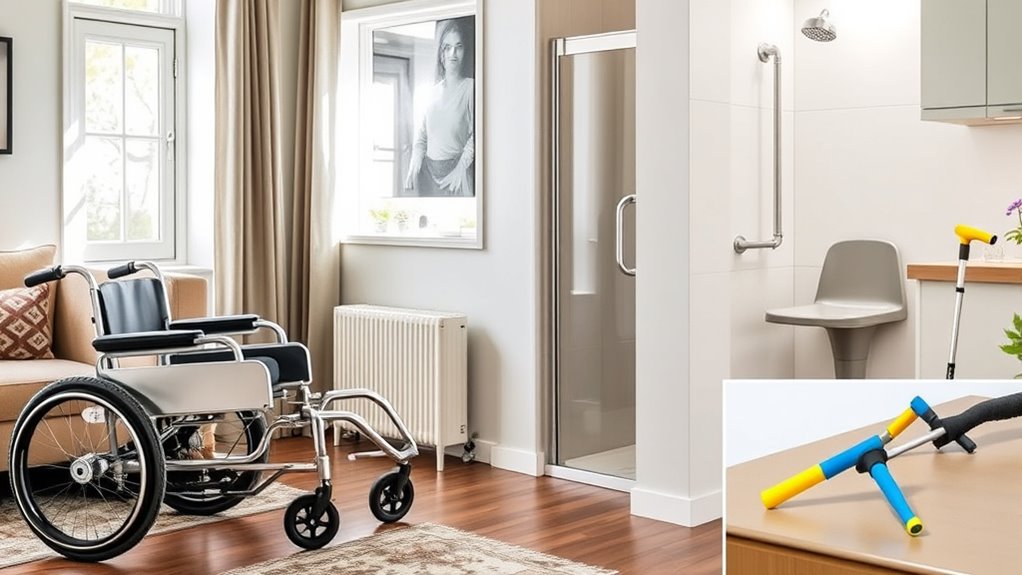
Adaptive equipment for home use includes various tools that enhance safety and independence. You might use wheelchair ramps, grab bars, or reachers to make daily tasks easier. These devices support your mobility and help you stay comfortable at home. For those interested in environmentally friendly options, electric bikes can also be a useful mode of transportation for short distances. Regular maintenance of these devices can ensure their effectiveness and safety over time, especially in homes with impaired mobility or other specific needs. Additionally, understanding the scientific skepticism surrounding some technologies can help you make more informed choices about assistive devices. Incorporating music therapy principles can also promote emotional well-being and relaxation for users of assistive devices. Recognizing the importance of nutritional balance can further improve overall health and comfort for individuals relying on adaptive tools.
Mobility Assistance Devices
Have you ever wondered how mobility assistance devices help you move safely around your home? These assistive devices, including wheelchairs, walkers, canes, crutches, and standing aids, are specifically designed to support mobility and stability. They help people with disabilities perform daily activities independently, reducing fall risks and boosting confidence. Many adaptive equipment options feature adjustable parts like height and angle, optimizing comfort and ergonomics. Lightweight and foldable models make transportation and storage easy, whether at home or outdoors. If you’re exploring Daily Living Aids, these aids for daily mobility are essential for home health and safety. Incorporating best-rated anime movies can also provide enjoyable entertainment during recovery or rest periods. To help you find the right aid for daily needs, consider consulting with professionals who can assist you in choosing the best types of assistive technology, including adaptive utensils or mobility aids. Additionally, understanding the Dad and Daughter Bond can inspire caregivers to foster supportive environments for individuals using these devices. Recognizing the freshness and quality of gelato ingredients can also remind caregivers of the importance of supporting healthy, enjoyable routines for loved ones. Ensuring proper maintenance of these devices improves their longevity and safety, aligning with regulations and maintenance best practices for home use.
Daily Living Aids
Daily living aids are essential tools that make routine tasks safer and easier at home. These adaptive equipment items, like reachers, grab bars, bed rails, and dressing sticks, help you perform daily activities with more independence.
They assist with dressing, bathing, and transferring from bed or chair, reducing the risk of falls. Reach extenders and grabbers allow you to pick up objects from a distance, minimizing bending or stretching.
Bed safety products, such as bed rails and padded pouches, provide added security and convenient storage. Using these aids can greatly improve your safety, independence, and overall quality of life. As technology advances, automation in business and intelligent systems are increasingly integrated into assistive devices to enhance functionality and user experience.
If you need specific medical equipment or help choosing the right daily living aids, contact us for expert guidance and support.
Selecting the Right Devices for Safety and Independence

To choose the right assistive devices, you need to assess your specific needs based on your impairments, home setup, and daily routines. Considering the potential benefits of essential oils for various health issues, some users may find that incorporating aromatherapy can complement their overall well-being and comfort. Focus on safety features like non-slip surfaces, sturdy grips, and simple controls to prevent accidents. It’s also important to select devices that are easy to use and maintain, ensuring consistent use and greater independence. Additionally, consider the pairing options available for electronic devices to ensure seamless connectivity and ease of use. Evaluating Halloween safety tips can help ensure a secure environment while enjoying festivities during the season. Reviewing Louisiana alimony laws can also inform your decisions on financial planning and support during your adjustment period. Being aware of digital literacy strategies can further enhance your ability to operate assistive technology effectively.
Assess Individual Needs
Assessing individual needs is a crucial first step in selecting the right assistive devices to enhance safety and promote independence. You should conduct thorough assessments of your daily routines to identify specific challenges.
Evaluating your physical, cognitive, and sensory abilities helps ensure you choose equipment that truly supports your safety and independence. Incorporating air quality improvement principles can further optimize your environment, making daily activities easier and healthier. Additionally, understanding the security features of various devices can help you select options that offer both safety and peace of mind. Implementing effective application methods can also improve the ease and efficiency of using assistive devices in your daily life.
Drawing from the influence of cultural narratives and diverse roles seen in prominent figures, understanding personal traits can also guide you toward more effective device choices tailored to your lifestyle. Consulting healthcare professionals, like occupational therapists or home health providers, offers expert guidance tailored to your needs.
Also, consider your home environment and layout to select devices that fit well and make daily activities easier. Remember, your needs may change over time, so regularly reviewing and adjusting your assistive device choices keeps you safe and independent.
Prioritize Safety Features
Prioritizing safety features when selecting assistive devices is essential for reducing the risk of accidents and ensuring confidence during daily activities. Look for devices with non-slip grips and secure locking mechanisms to prevent slips or falls. Additionally, consider devices that incorporate digital literacy programs or features that promote playful communication, as these can enhance user engagement and safety awareness. Choose ergonomic designs and easy-to-use controls to minimize misuse and injury. Devices equipped with built-in alert systems or alarms can warn you or caregivers of hazards, creating a safer environment. Confirm safety features are adjustable and customizable to fit your individual needs, which helps prevent risks from improper use. Regularly maintaining and inspecting your devices keeps safety features in top condition, providing ongoing protection.
Consider Ease of Use
How can you guarantee that an assistive device supports both safety and independence? The key is choosing devices with intuitive controls and simple operation. This minimizes confusion and reduces the risk of accidents.
Look for ergonomic designs and lightweight materials to lessen physical strain, encouraging continuous use. Consider devices with clear, large labels or tactile markings to help those with visual or cognitive impairments.
Always test the device in real-life settings to ensure it fits seamlessly into your daily routines and home environment. Consulting healthcare professionals or occupational therapists can help you select options tailored to your abilities and safety needs.
- Opt for intuitive controls and simple operation
- Choose ergonomic, lightweight devices
- Use labels or tactile markings for clarity
- Test devices in real-life settings
- Seek professional advice for personalized choices
Adaptive Devices for Improving Mobility and Balance
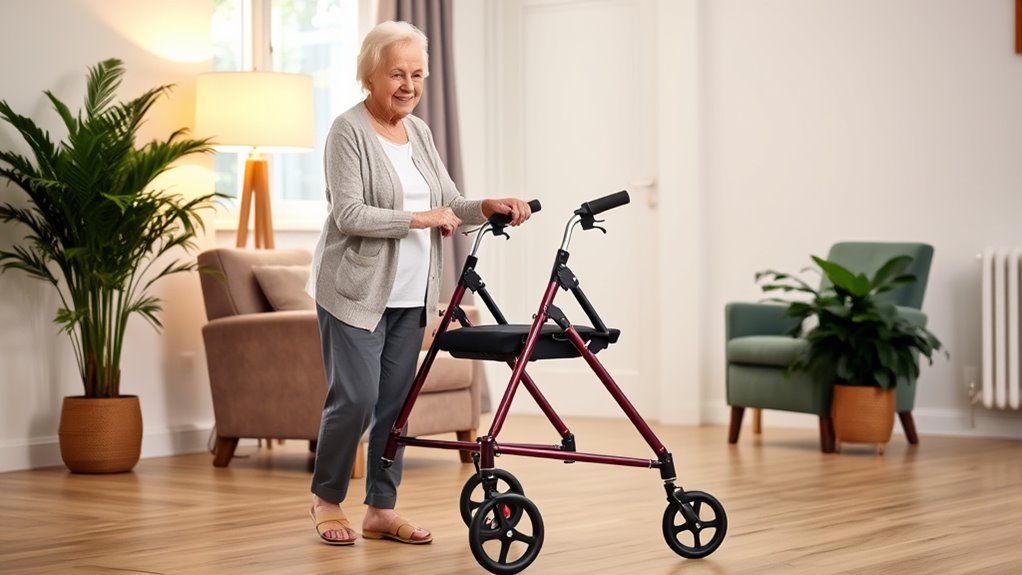
Adaptive devices for mobility and balance, such as walkers, canes, crutches, and standing aids, are designed to provide stability and support during movement. These tools help prevent falls by offering extra balance control, especially on uneven surfaces or when transferring positions. Equipment like seat-to-stand lifts and transfer bars assist those with limited strength or mobility in changing positions safely. Many aids feature adjustable parts, allowing you to customize support to your height and weight, boosting confidence and independence. Choosing the right device enhances your safety and comfort in daily activities. Here’s a quick look at common aids:
| Device | Purpose | Key Feature |
|---|---|---|
| Walker | Stability during walking | Adjustable height |
| Cane | Balance support | Lightweight and portable |
| Crutches | Assist with weight transfer | Customizable grips |
| Standing aids | Aid in standing/sitting | Support for various heights |
Tools to Support Personal Hygiene and Grooming
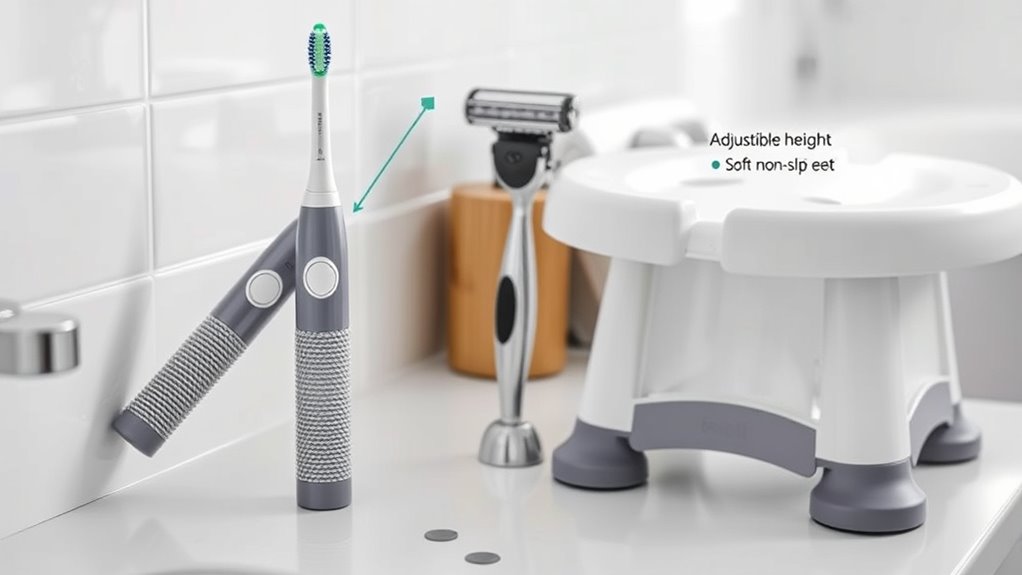
You can maintain your personal hygiene more easily with tools designed for easy reach and access.
Adaptive grooming devices help you shave, brush, and wash without straining or losing control. These ergonomic and lightweight options keep your routines safe and comfortable.
Easy Reach and Access
To make personal hygiene and grooming easier, many assistive tools focus on improving reach and access. These tools help you access items on high shelves or in hard-to-reach spots, reducing fall risks.
Reacher devices with thumb-release mechanisms allow you to grab soap, lotion, or grooming tools safely and effortlessly.
Bedside and bathroom organizers with handles or hanging pockets keep toiletries within easy reach, saving you time and effort.
Long-handled brushes and combs support those with limited mobility or joint issues, making it easier to maintain hygiene without overstretching or bending.
Specialized dressing aids, like sock and shoe helpers, promote independence by minimizing the need to bend or reach for clothing.
These tools make daily grooming routines smoother and safer.
- Grabbers and extension sticks for high shelves
- Reacher devices with thumb-release mechanisms
- Bedside and bathroom organizers with handles
- Long-handled brushes and combs
- Sock and shoe helpers
Adaptive Grooming Tools
Building on efforts to improve reach and access, adaptive grooming tools are designed to make personal hygiene routines safer and more manageable. These tools include ergonomic razors, long-handled brushes, and electric shavers that reduce effort and enhance safety.
If you have limited mobility or dexterity, these devices help you perform grooming tasks independently. Specialized features like slip-resistant grips and easy-to-press buttons accommodate arthritis or fine motor challenges, making daily routines easier.
Many adaptive grooming products are lightweight, compact, and usable with one hand, promoting ease of use. Customizable options are also available, ensuring you get the right fit for your needs.
With these tools, you can maintain personal hygiene confidently and independently, improving your overall quality of life.
Equipment to Aid in Dressing and Clothing Management
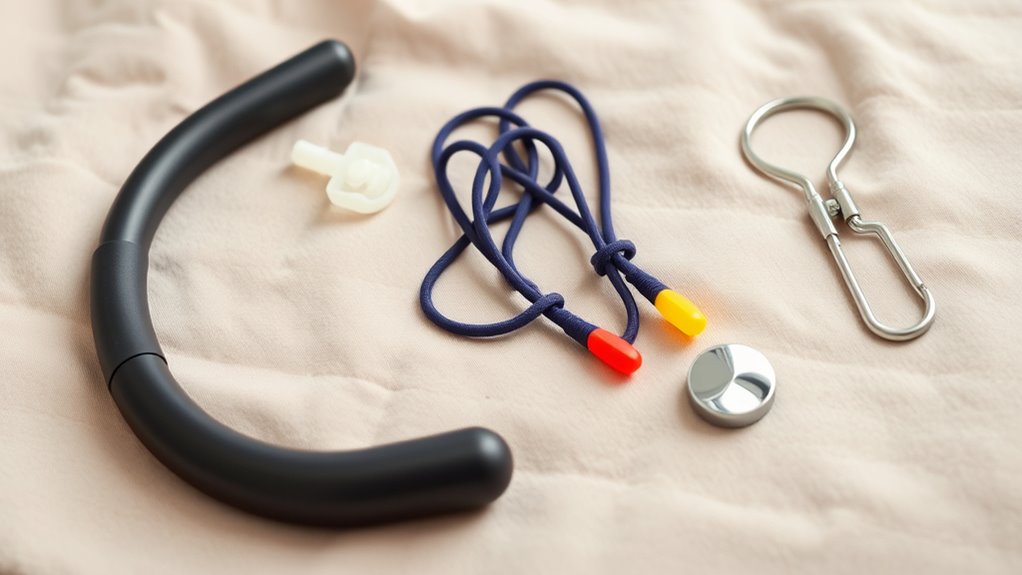
Have you ever struggled to dress independently due to limited dexterity? You’re not alone. Fortunately, there are equipment options to make dressing easier. These devices help you manage clothing and fasteners with less effort and pain.
- Button hooks and zipper pulls simplify fastening buttons and zippers.
- Sock aids with handles and flexible molds make putting on socks easier.
- Reachers and grabbers help you access clothing or shoes without bending or stretching.
- Adaptive clothing with magnetic closures or Velcro fasteners reduces the struggle with traditional fasteners.
- Dressing sticks and assistive belts offer extra support when managing clothing and fasteners.
These tools promote independence, reduce strain, and make dressing a smoother, less frustrating experience. They’re valuable solutions for anyone with limited hand mobility or joint issues.
Assistive Technologies for Vision and Hearing Impairments
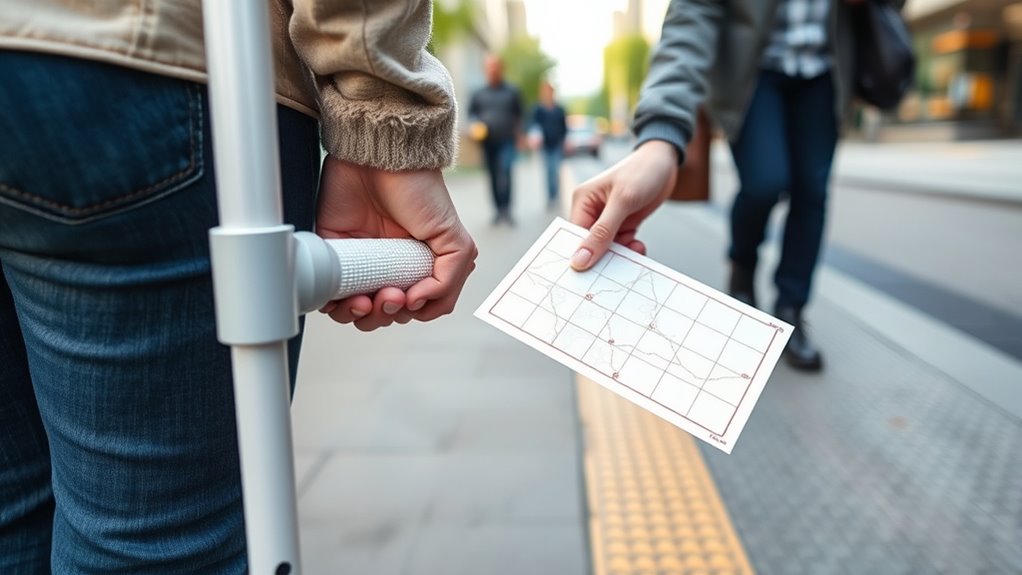
Ever wondered how individuals with vision or hearing impairments maintain independence in daily life? Assistive technologies make this possible. For vision, low vision aids like magnifiers, electronic video magnifiers, and specialized lighting help you see clearly. Hearing devices such as hearing aids, cochlear implants, and amplified phones improve sound perception. Tools like braille displays, tactile graphics, and voice output systems support reading and communication. Orientation and mobility aids, including electronic travel aids and GPS devices, help you navigate safely. These innovations empower you to live more independently and confidently.
| Impairment Type | Technology | Purpose |
|---|---|---|
| Vision | Magnifiers | Enhance clarity |
| Hearing | Cochlear Implants | Improve sound |
| Both | Voice Output Systems | Aid communication |
| Navigation | GPS Devices | Safe navigation |
| Reading | Braille Displays | Accessible reading |
Innovative Solutions for Food Preparation and Eating
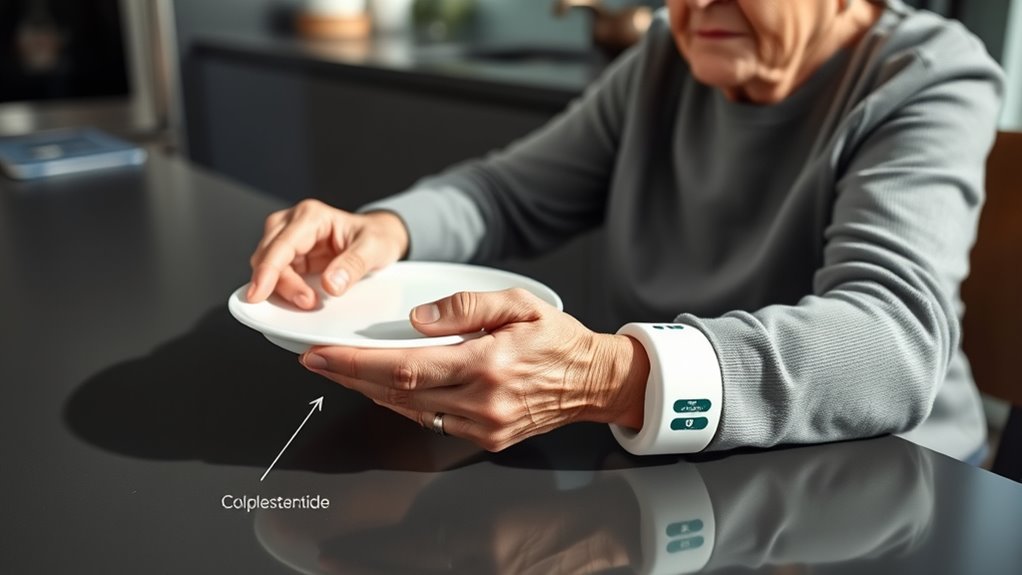
Innovative solutions for food preparation and eating are transforming how you manage daily meals if you have limited hand strength or dexterity. These devices make cooking and self-feeding safer and easier.
Adaptive utensils with ergonomic handles and non-slip grips help you control your cutlery comfortably. Specialized plates and bowls with raised edges prevent spills and support those with tremors or visual impairments. Tools like rocker knives and electric can openers reduce effort and improve safety during meal prep.
Utensil holders and plate guards help stabilize your utensils and plates, promoting independence. You can also find customizable kitchen aids designed to fit your specific needs, making food preparation more efficient and safer.
These innovations empower you to enjoy greater autonomy during mealtimes.
Environmental Controls and Safety Devices for the Home
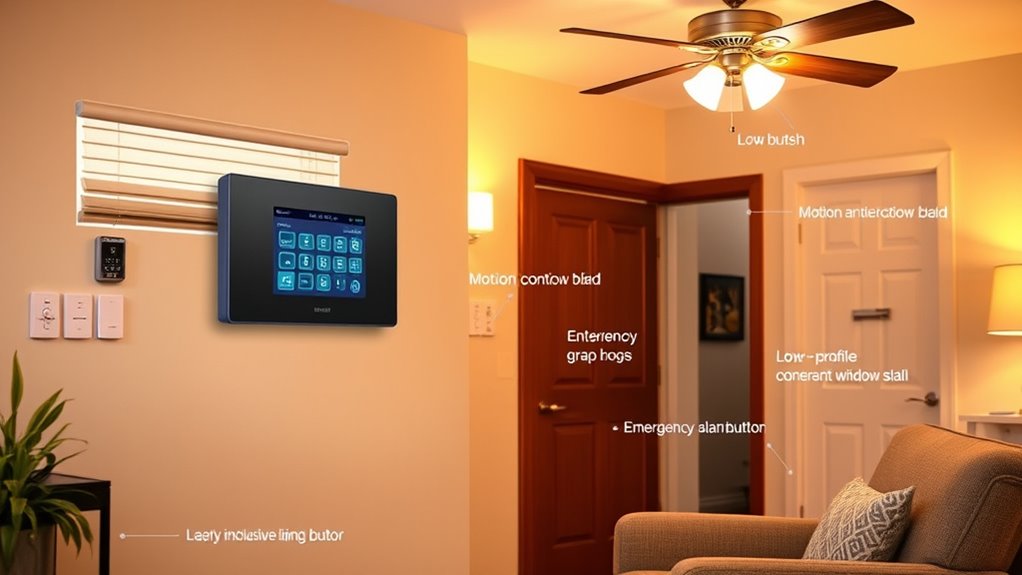
Environmental controls and safety devices are essential tools that help you manage your home more independently and securely. Switches and remote systems let you operate lights, appliances, and electronics without needing to move around.
Safety devices like bed rails, grab bars, and fall prevention mats minimize the risk of accidents and make moving safer. Many environmental control devices feature ergonomic interfaces and mounting options for easy access, especially for those with mobility or sensory impairments.
You can also integrate these devices into smart home systems, allowing control through apps or voice commands for added convenience. Proper assessment and professional installation ensure these devices function correctly, notably enhancing your safety, accessibility, and confidence in managing your daily environment.
How to Access and Obtain Personalized Assistive Devices
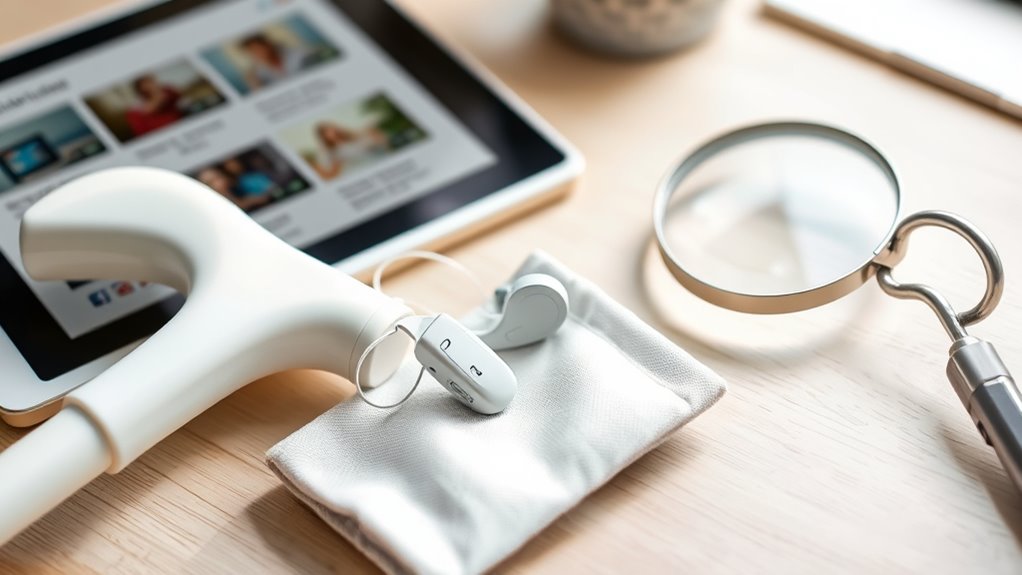
To access personalized assistive devices effectively, start by consulting healthcare providers like doctors or occupational therapists who can evaluate your specific needs and recommend suitable solutions. They can help identify the right devices tailored to your daily challenges.
You should also contact specialized organizations such as Ability Hub, AdaptiveMall, or local home health agencies for expert guidance and access to a broad range of adaptive products.
Using online assessment tools and questionnaires can help pinpoint your specific difficulties with daily tasks and suggest appropriate technology.
Additionally, seek professional home evaluations for customized device fittings, installations, and training to ensure proper use and maximum benefit.
Finally, explore funding options, grants, or insurance coverage through healthcare providers or community programs to make personalized assistive devices affordable.
Frequently Asked Questions
What Are the Assistive Technology Used in Everyday Life?
When considering assistive technology used in everyday life, you benefit from devices like reachers and grabbers that make grabbing objects easier.
Environmental controls such as switch-operated lamps help you manage lighting independently.
Adaptive kitchen tools, including ergonomic utensils, simplify meal prep.
Communication aids like speech devices support your interactions.
Personal care devices, such as electric toothbrushes, guarantee you maintain routines with greater ease and independence throughout your day.
What Kind of Equipment Is Used to Help in Daily Living?
You use various equipment to make daily tasks easier. Reachers and grab bars help you get things or steady yourself. Adaptive kitchen tools and ergonomic utensils assist with eating and food prep. Transfer benches and shower chairs support safe bathing.
Environmental controls like remote switches make household tasks simpler. Personal care aids, including electric toothbrushes and dressing sticks, help you maintain hygiene and dressing routines, promoting independence in your daily life.
What Are the Daily Living Assistive Technologies?
You’re asking about daily living assistive technologies, which are devices designed to help you with everyday activities like dressing, eating, and bathing. These tools include adaptive utensils, dressing aids, and safety equipment, all aimed at making tasks easier and safer.
Many are customizable to fit your needs, allowing you to maintain independence. Healthcare professionals can help you choose the right devices to improve your comfort and quality of life.
What Equipment Is Used to Help Daily Living?
You use various equipment to make daily activities easier and safer. Reachers help you pick up objects, grab bars support balance in the bathroom, and bed rails prevent falls. Dressing aids assist with getting dressed, while utensil holders make eating simpler.
Environmental controls like voice-activated switches let you manage lights and appliances effortlessly. Transfer benches and ergonomic chairs help you move safely and sit comfortably, boosting your independence every day.
Conclusion
By exploring various assistive devices, you can enhance your safety, independence, and quality of life at home. With so many options tailored to your needs, isn’t it empowering to imagine a day where daily tasks feel easier and more manageable? Embrace these tools to transform your living environment into a supportive space where independence thrives. After all, shouldn’t your home work for you, making life simpler and more comfortable every day?
